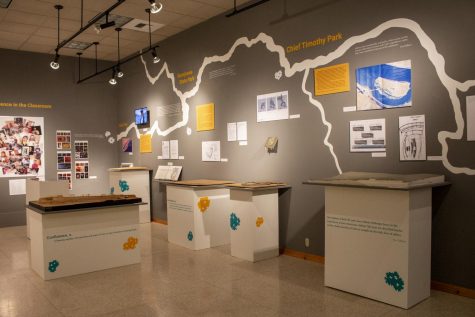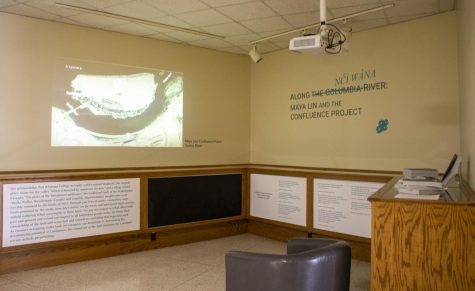At the intersection of art and environmental activism: Maya Lin’s Confluence Project comes to Maxey Museum
May 6, 2021
At six sites stand markers for historical points of settler colonial and Indigenous interaction. In dialogue with the commemorations of Lewis and Clark’s expedition is the Confluence Project, a series of Earthworks designed by world-renowned artist Maya Lin.
The project seeks to bring native voices into conversation about the expedition and to challenge the Eurocentric narratives that permeate discussions regarding Lewis and Clark. The Earthworks are large-scale architectural works that operate in conjunction with the landscape. Some of the six sites include “story circles” at Sacajawea State Park and an elliptical bird blind at the Sandy River Delta.
The project originated at Whitman as an exhibition in the Maxey Museum entitled “Along the Columbia River: Maya Lin and the Confluence Project.” It is featured as part of the series “Extraction: Art at the Edge of the Abyss,” which platforms work that deals with climate change and environment.

The Maxey Museum hosted a digital discussion for the exhibit, and of the Confluence Project more broadly. The discussion was led by Associate Professor of Art History and Visual Culture Studies Matthew Reynolds and Associate Archivist Dana Bronson, who gave context about the exhibit and talked about Whitman’s role in the project.
Professor Reynolds was integral to establishing and curating this exhibit, and spoke about the nature of the Confluence Project and how the Maxey exhibit differs from the project as a whole.
“This exhibit also explicitly connects the Confluence Project with climate change and the environment,” Reynolds said. “If you go to visit any of the sites, they are fascinating and can be very poignant and moving… I’ve also had the experience of going there and it being underwhelming. But at these locations there is a ton of work. I think this exhibit goes into the complexity.”
Audrey Mace, a junior film and art double major, became involved with the Confluence Project while doing research for the archive. This helped her build connections with the staff and faculty community. Eventually, she became a curator for the exhibit at Maxey. She has also made a short film about the project which was sent to staff working the Confluence Project, including Maya Lin. Mace found that the project was a fascinating and relevant because it touches on aspects of many different areas of study:
“I think it’s really good for classes — a lot of disciplines of classes. It touches on many things. It could be a controversial thing for some people. I think this exhibition is really cool, if you look at it from a broader view. I would recommend just going to it and seeing what it is,” Mace said.
Another student, senior biology major Camille Marshall also curates the Maxey Museum. Marshall took a class with Professor Reynolds, which involved a lot of student work. Marshall found herself increasingly invested in the work they undertook, and wanted to continue it. She said that although Maya Lin played a major role in designing these Earthworks, it’s important to look at the project from a broader perspective:
“I think the Confluence Project is very humbling because so many people were working on it,” Marshall said.

Marshall also talked about the controversy around one location for the Confluence Project, Celilo Park. The site is fraught with political implications and differing opinions. Once an important site for fishing and trade for many Indigenous communities, the U.S. government built a dam on the Columbia River that destroyed the waterfall there and severely damaged the ecosystem. A project was intended to be built there to reckon with the history and grief tied into the land, but after the Yakama Nation withdrew support, the project was left in uncertain waters with no plans for completion.
The exhibit portrays not only the Confluence Project itself, but the context surrounding it. From letter campaigns and controversy to ambitious Earthworks, the Maxey Museum weaves together the intricate tapestry of this project and all that went into it.
The exhibition is open starting April 23, 2021, to the end of fall semester 2021, from noon to 4 p.m. on Wednesdays through Saturdays.





